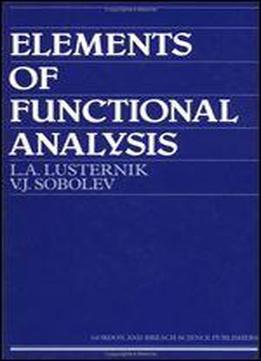
Elements Of Functional Analysis Of L. A. Lusternik
by L. A. Liusternik /
1961 / English / DjVu
6 MB Download
PREFACE TO THE FIRST RUSSIAN EDITION
During the past few decades, the methods of functional analysis, especially the researches of Soviet mathematicians, have found extensive applications in various branches of pure and applied mathematics. The basic concepts of functional analysis now form an integral part of the mathematical courses at
universities. An article by L. A. Lusternik appeared as the first comprehensive exposition of functional analysis in the first volume of the journal, Uspekhi Matern. Nauk. This was followed by a cycle of articles published in the UMN. It was, therefore, appropriate that no claim was made to completeness, not even in the sections dealing with functional analysis. Based on these
articles V. J. Sobolev developed a lecture series on functional analysis, which he delivered several times at the State University of Voronezh.
These lectures inter alia covered a number of topics which were not dealt with in the article referred to above, for example, the principle of contraction mappings, the general form of linear functionals, the spaces with basis, the theory of completely continuous operators, the spectral representation of bounded self-adjoint operators, etc. The present text is the outgrowth of these lectures. The last section of the article, which dealt with the calculus of variations from the functional-analytic viewpoint, has been incorporated in the last chapter of the book in an expanded form.
The first chapter deals with the metric spaces. However, the approach is from a different angle, for example, as in the works of ALEXANDROV, An Introduction to the General Theory of Sets and Functions and HAUSDORFF, Theory of Sets. In a sense, this chapter is an extension of these works. The second and third chapters are devoted to normed linear spaces and linear operators.
The motivation of the fourth chapter is the exposition of the theory of completely continuous operators in spaces with basis. An account has) however, been given of all spaces important for functional analysis.
The fifth chapter is focused on the spectral theory of self-adjoint operators. This topic is of key importance in modern analysis, and much has been written on it. A few works on this topic have been cited in the bibliography given at the end of this text. In the interest of curricular economy, the treatment here is confined to the exposition of fundamental notions and the discussion of bounded self-adjoint operators, presenting as much material as considered adequate for concentration on the methods of spectral theory.
The last chapter deals with operations for abstract functions. Differentiation and its applications have been discussed at length.
The authors have taken pains to illustrate the theory by application to different branches of mathematics - Theory of Differential and Integral Equations, Approximation Methods in Analysis, Theory of Almost Periodic Functions, Calculus of Variations etc.
At several places, examples have become somewhat lengthy. These have to be, however, included in order to make explicit the relations between functional analysis and other branches of mathematics.











